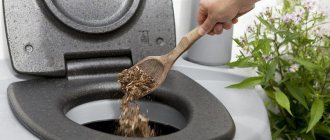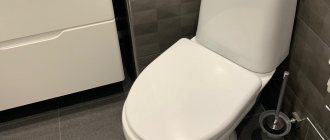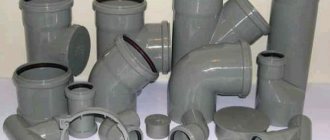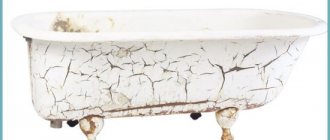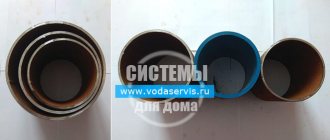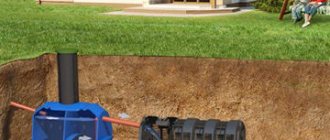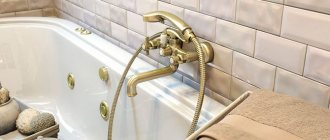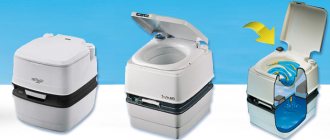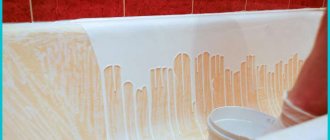Bathtub restoration enamel is used to restore the operational and aesthetic function of a leaky cast iron bathtub. The restoration procedure itself consists of applying enamel to a previously prepared bath surface.
Enamel for bathroom restoration
Bathtubs made of cast iron have a maximum service life. They last for decades with little wear and tear. They are virtually shock-resistant, resistant to most types of mechanical damage, and do not require complex maintenance. You can read how to choose a bath in our article..
Bathtub restoration
The protective layer of enamel, which is usually used to cover cast iron bathtubs, also has good wear resistance. But even with proper care, after ten years of use it can lose its consumer properties. It is quite possible to restore the top layer of bathtub enamel on your own.
Bathtub restoration - before and after
After some time, defects such as:
- yellow tint , which begins to appear more and more during the operation of the bath, greatly deteriorating its aesthetic properties. This effect is caused by constant interaction with water containing iron in high concentrations;
- cracks and chips that appear on the enamel after any weight falls on it, as well as from sudden changes in temperature. If the fallen object is quite weighty and small in size, then pieces of enamel may even fly off the cast iron;
- abrasions that appear on the enamel coating after numerous cleanings of a cast-iron bath using brushes with coarse bristles and household chemicals with abrasive particles to remove dirt.
Bathtub enamel
What types of enamels are there for bathroom restoration?
Nowadays there is a decent selection of different products for restoring bathtub enamel on sale. Repair experts recommend paying attention when choosing high-quality enamel for repairing the surface of a cast-iron bathtub on the following parts.
Restoration of a cast iron bathtub
Methods for applying enamel coating differ in the tools used. The smoothest and highest quality surface is obtained using a brush. Using a roller you can also achieve good results. But the aerosol is only suitable for masking small coating defects. If you try to apply such enamel on a large surface, you can get a non-uniform shade of the bath.
Enamel for restoration of bathtubs and ceramics
Important! It is advisable that the basic product kit includes all the necessary additional components. Before applying a new layer of enamel, the old one must be properly cleaned and prepared. Therefore, in addition to the enamel itself and the hardener, the set of bath restoration products should include reagents for preliminary surface preparation.
The hardener must be included in the two-component enamel kit. You should take a closer look at the color of the hardener. This determines whether the enamel will develop any undesirable tint. The tinting pastes that come with some of these sets of products will help prevent this undesirable situation. The visual perception of enamel color directly depends on the illumination of the room where the bathtub is installed. To achieve a winning shade, it is better to select the tone in the same room.
The new bath color can be anything
The most popular bath enamels are:
- "Reflex-50";
- "Epoksin 51 (51C)";
- "Stakryl Ecolor".
Buying paint
Naturally, if the bathtub is old and its coating is not very attractive, then, if you have sufficient finances, you can purchase a new one. And if outwardly it still looks okay, and the enamel is damaged, then you should think about restoring the plumbing by painting.
Naturally, bath paint must be water-repellent, since ordinary paints are not so resistant to moisture and adhesion will be weak . Today on the market you can find a huge number of all kinds of paints and varnishes with a water-repellent effect.
However, when purchasing restoration enamel or other coloring agent, remember the following:
- the coating must be durable;
- the paint should preferably have antibacterial properties;
- must not contain harmful components hazardous to human health;
- must be resistant to mechanical and chemical damage;
- must have low thermal conductivity in order to maintain water temperature for a long time.
Enamel "Epoksin-51" and "Epoksin-51S"
"Epoksin-51 (51C)" belongs to the class of two-component enamels. They are produced here, but on the basis of German components. Hardener included. After applying such enamel, the bathtub can be cleaned using products that have disinfectant properties.
"Epoksin-51"
The enamel coating obtained using these products can last up to 9 years. To do this, the enamel must be applied in even layers, strictly following the technological process. The appearance of a yellow tint is prevented by special ingredients included in the composition. Using tinting paste allows you to expand the color options for your updated bathtub. A mixture of enamel and hardener will reliably smooth out small irregularities in old enamel, filling cracks and chips.
Colors for enamel
On a note! Epoksin-51C differs from Epoksin-51 enamel in that the curing time is halved. After applying the product, the bath will be available for use within 24 hours.
Enamel "Epoksin-51S"
Epoksin-51 enamel can be diluted with a solution of ethyl alcohol and acetone (1:1) for thinning and ease of application. In this case, the share of the diluent should be no more than 10% of the volume of the entire mixture.
Unlike its brother, Epoksin-51C cannot be diluted, and this is its disadvantage. It itself is quite thick, so it is difficult to apply to the surface.
You may be interested in information about which bathtub to choose: acrylic steel or cast iron
If you are renovating your bathtub yourself using these brands of bathtub enamels, then you need to consider the speed of the repair work. After an hour, the mixture of enamel and hardener becomes unusable. This is due to the chemical reactions occurring in it, as a result of which it becomes harder. Therefore, the enamel must be applied to the surface of the bath within an hour.
Bathtub restoration scheme using self-leveling enamel
Restoration of the enamel layer
We carry out our own repairs of chipped enamel of metal bathtubs made of cast iron and steel using the following technology:
- cleaning the metal in the defective area with coarse sandpaper;
- removing dust with a vacuum cleaner or washing with a cleaning agent without abrasive impurities;
- solvent degreasing;
- preparing an acrylic mixture or epoxy enamel;
- layer-by-layer application of enamel paint or filling the cavity with self-leveling acrylic in one step.
Applying enamel from an aerosol can
After laying the repair mixture on the chip site, it should protrude like a bump above the factory coating adjacent to this area. After the composition has hardened, this tubercle is polished with abrasive materials with a change in grain size from larger to smaller. Next, polishing is carried out with a special paste.
To avoid getting new scratches with sandpaper, cover the chipped area around the perimeter with masking tape.
Small chip
Repairing a chip on a small bathtub with your own hands is quite simple. The main nuances of restoration work in this case are:
- cleaning of cast iron and steel is impossible due to the microscopic size of the defect;
- instead, rinsing is done with a chlorine-free cleaning agent;
- It is economically feasible to use repair kits in small packaging (syringes, cans, barcode correctors);
- application in one go.
Preparation of the mixture according to the manufacturer's instructions.
The product can be applied with a brush; it is more convenient to level the material on the surface with a spatula.
Applying acrylic reducing agent with a homemade wooden spatula made from wood chips.
Manufacturers of some bathtubs open their inner surface with varnish. Therefore, after repairing a defective area, it may be necessary to apply one or two layers of varnish.
Enamel "Stakryl Ecolor"
Liquid acrylic is the basic component in the production of this enamel. All its ingredients also come from Germany. "Stakryl Ecolor" differs from "Epoksin" in that it is not capable of filling cracks in old enamel. Before use, it is recommended to carefully fill all surface irregularities.
When carrying out restoration work, Stakryl Ecolor enamel is applied using the pouring method. A uniform layer will be obtained if you have a certain dexterity and skill in this type of activity.
"Stakryl Ecolor"
Important! The two-component solution “Stakryl Ecolor” contains epoxy resin. The mixture hardens within 70 minutes after mixing, so it must also be applied as quickly as possible.
When carrying out repair work, you need to use protective equipment, since the liquid mixture is toxic and, if it comes into contact with the skin, causes dermatitis. And only after final hardening it becomes absolutely safe.
“Stakryl” is a continuation of the “Epoksin-51” line of products. Therefore, preparatory work on treating the surface of the bathtub before applying enamel is carried out in the same way. And the tinting pastes for obtaining the desired shade of the coating based on “Stakryl Ecolor” are taken from the “Epoksin-51” set.
"Stakryl Ecolor", enamel for restoration of bathtubs
It is not advisable to use thinners for Stakryl enamel, as it can damage the structure of the composition. As a result, after the repair work, it will be noticeable that the thickness of the resulting new layer of enamel is not the same over the entire surface of the bathtub.
When adding tinting paste, the dosage must be strictly observed. Exceeding the permissible amount of paste will result in an uneven shade and the strength of the enamel coating will be insufficient.
Enamel "Stakryl"
Types of compositions for cold enameling
To renew bathtubs, you need a high-quality coating that is highly resistant to temperature changes, water and chemical cleaning agents. The most commonly used paints are epoxy paint and liquid acrylic.
Latex or acrylic enamel
This two-component material should be mixed well immediately before use. Experts include the following advantages of liquid acrylic:
- strong adhesion to the surface to be coated;
- high abrasion resistance;
- easy care;
- low thermal conductivity, allowing you to retain heat for a long period.
Glossy paint maintains its shine for a long time. The bathtub is safe to use because it becomes non-slip.
The product is applied by pouring onto the sides of the bath, from where it flows down, forming a new layer. This requires a large amount of material and financial costs. The coating has several other disadvantages:
- toxicity;
- Strong smell;
- uneven distribution over the surface.
Cleaning products must not contain alkalis or acids. To improve adhesion, the base of the bathtub is primed. Poor preparation will lead to rapid peeling of the enamel.
Two-component epoxy enamel
This suspension contains epoxy resin, fillers, and pigments. The product is two-component; before work, a hardener is added and the composition is thoroughly mixed. Apply with a brush to avoid drips. It is difficult to scratch the surface. The following advantages are highlighted:
- good adhesion (adhesion) to metals;
- high wear resistance;
- the ability to care with abrasive agents;
- insensitivity to acids and alkalis.
The hardened layer is homogeneous, smooth, and glossy. The material has a low price. Disadvantages include rapid loss of whiteness, toxicity, and unpleasant odor. To avoid the appearance of drips, the consistency of the solution must not be disturbed.
Epoxy enamel Tikkurila Temacoat RM40.
Aerosol products
Various formulations are available in aerosol form, ready for use; you just need to shake the can. The advantages of use include:
- easy application;
- uniform distribution of paint;
- the ability to imitate different textures using additives.
It takes less than a day to paint, cure and achieve a shiny finish. The disadvantages of aerosols include the insignificant thickness of the applied layer, which is quickly erased, and the liquid consistency of the composition due to the large proportion of solvent.
The inner surface of the bath must be carefully prepared. This method is short-lived. The updated version will last 10-12 months, then chips and yellowish stains will begin to appear.
Enamel "Reflex-50"
This product is one of the most expensive in the bath enamels segment. Professionals highly appreciate the quality characteristics of this enamel.
"Reflex-50"
The product is equipped with a hardener, therefore it also belongs to the category of two-component enamels. Fundamentally, in its properties and method of application, it is not very different from solutions of other similar brands.
Two-component bath and pool paint, white
The only negative is that the bathtub restored with its help will be available for use only after a week.
Stages of restoring bathtub enamel
Prices for bath enamel
bath enamel
Reviews
At the moment, there are various comments on the Internet regarding this processing option. Let's look at some reviews:
- I am very pleased that I used this particular enamel option. Yes, the result obtained cannot be called durable, but you won’t have to wait a week before you can use the bathing container. The only downside that should be noted is the strong and poorly ventilated smell.
- It’s nice that this coating option has also appeared for bathtubs. For a long time I did not decide to restore it, but having chosen this type of enamel, I decided to try it. I did everything according to the instructions and got an excellent result. The final result is difficult to distinguish from the initial appearance. In general, I recommend it to everyone.
In practice, there are many reviews regarding the quality of paint and its properties, but you cannot blindly trust them, since these statements do not always correspond to reality.
Step-by-step instructions for applying enamel
The procedure for restoring a bathtub is not complicated. For the convenience of visitors, the instructions are presented in table form.
Acrylic enamel and necessary tools for restoration
Table. How to restore a bathtub using enamel.
| Steps, photo | Description of actions |
| Step 1 | Preparatory work. Cover the drain, faucet and other parts that you don’t want to get dirty with masking tape. |
| Step 2 | Degreasing the bath and removing dirt. Sand the surface to make it rough. After this, the resulting dust must be removed. You can use a vacuum cleaner for this. Then we rinse the bathtub with water and dry it, wiping it with a cotton cloth. |
| Step 3 | Prepare a mixture of primer and hardener. Pour some of the primer onto the bottom. Using a roller, apply primer to the remaining surface of the bathtub. Remove the tape. |
| Step 4 | Before starting painting, protect the drain, faucet and other parts that need protection with masking tape. We wait for the primer to dry (about a day). |
| Step 5 | We perform intermediate grinding. |
| Step 6 | After sanding, clean the bath from any particles that have formed. You can use a vacuum cleaner. |
| Step 7 | Rinse with water and dry the surface thoroughly. |
| Step 8 | Enamel preparation. Mix a jar of enamel with hardener. In other cases, enamels are produced in a composition that does not need to be mixed. |
| Step 9 | Apply some of the enamel to the bottom of the bathtub. |
| Step 10 | Using a roller, spread the enamel over the remaining surface. After a week, the bath can be used. |
How to choose the right paint material
How to choose the right enamel for your bath
In order to find out what is the best way to paint the bathtub, you need to determine the degree of damage to the plumbing and the appropriate type of paint and varnish products. Many people wonder: how to paint the inside of a bathtub if the damage to the enamel layer is significant (there are deep chips and cracks).
- Firstly, in such a situation, plumbing needs to carry out thorough preparatory work.
- Secondly, in order to achieve smoothness of the previously primed surface, and in this case it is simply necessary, the paint for painting the bathtub must be thick.
Conclusion: Answering the question of what kind of paint can be used to paint a bathtub, it is worth saying that latex and two-component enamel materials are best suited. In the second option, the composition is diluted with a hardener, so the consistency of the paint should be thick. Such paint for bathtub repair will help hide minor defects and uneven surfaces of the plumbing fixtures.
A frequently asked question from consumers is what paint can be used to paint a bathtub if the surface of the plumbing fixtures has become matte?
If the inside of your plumbing fixture does not have any flaws, except for the lack of a mirror shine, this only indicates that the plumbing fixtures have not been properly maintained. Most likely, the enamel surface was exposed to acids or alkalis, so its top layer was simply “eaten away.”
Is it possible to spray paint the bathtub in this case? Yes, such minor damage can be easily repaired using paints and varnishes in cans, but you need to figure out what kind of paint to paint the bathtub with. Metal, cast iron, and acrylic plumbing fixtures can be treated with latex paint in the form of a spray, but enamel materials cannot be used to restore acrylic plumbing fixtures.
Annoying mistakes: what to watch out for
Independent work on updating a bathtub with liquid acrylic requires not only adherence to a certain technology
It is also important to avoid making gross mistakes that will ruin all your efforts. Moreover, knowing about the features of the material itself and not having practical experience working with it, it is quite easy to miss something important. In the future, such small nuances will quickly render the recently restored enamel unusable.
It may begin to flake and peel off the surface of the bathtub.
In the future, such small nuances will quickly render the recently restored enamel unusable. It may begin to flake and peel off the surface of the bathtub.
The main mistakes made during restoration work:
- buying a fake instead of liquid acrylic;
- incorrect mixing of components;
- poor surface preparation;
- moisture residues in hard-to-reach places;
- unsuitable temperature conditions;
- ingress of dust and other inclusions;
- early operation of the restored capacity.
The undoubted advantage of self-leveling acrylic is that it is able to cope with the restoration of absolutely any bathtub - both small and huge. The main thing is to buy enough material
Unscrupulous sellers, in order to profit from inexperienced consumers, offer expensive acrylic made in Finland, Germany or Slovenia. In fact, these countries have not heard anything about the products supposedly produced in them.
Another mistake is incorrectly mixed ingredients. To avoid such an annoying misunderstanding, you need to carefully read the manufacturer’s instructions and only then begin to follow them to the letter.
Instructions and useful recommendations from the material manufacturer are usually printed on the back of the can of acrylic enamel, which is to be mixed with the hardener.
If you prepare the surface of a restored bathtub “at random”, ignoring the recommendations of experienced craftsmen, the result will be disastrous. Within a month, bubbles will appear and the gloss will peel off, revealing the dull outlines of the old container.
Water remaining in some places will ruin the entire work. The fact is that liquid acrylic will peel off from a wet surface.
All work must be carried out at a temperature not exceeding 25°C. Otherwise, the drying process of the material can significantly speed up, which is especially sad for the home craftsman. An experienced specialist, having assessed the temperature in the room, will act in accordance with it.
The ingress of dust, drops of water, lint from towels and other foreign objects onto the wet surface of the restored enamel will ruin its appearance. Trying to correct such a nuisance can make the situation even worse. It is better not to use the room at all until the surface is completely dry.
If the restoration is done correctly, then the old bathtub is absolutely indistinguishable from the new one. She is beautiful, shiny and snow-white
Knowing about all these mistakes, you can try to avoid them. Then the work will be done with high quality, and the updated plumbing will delight you with its ideal smoothness and long service life.
The subtleties of repairing cast iron bathtubs are given in the following article. It describes in detail the technology for restoring plumbing fixtures and provides useful recommendations.

